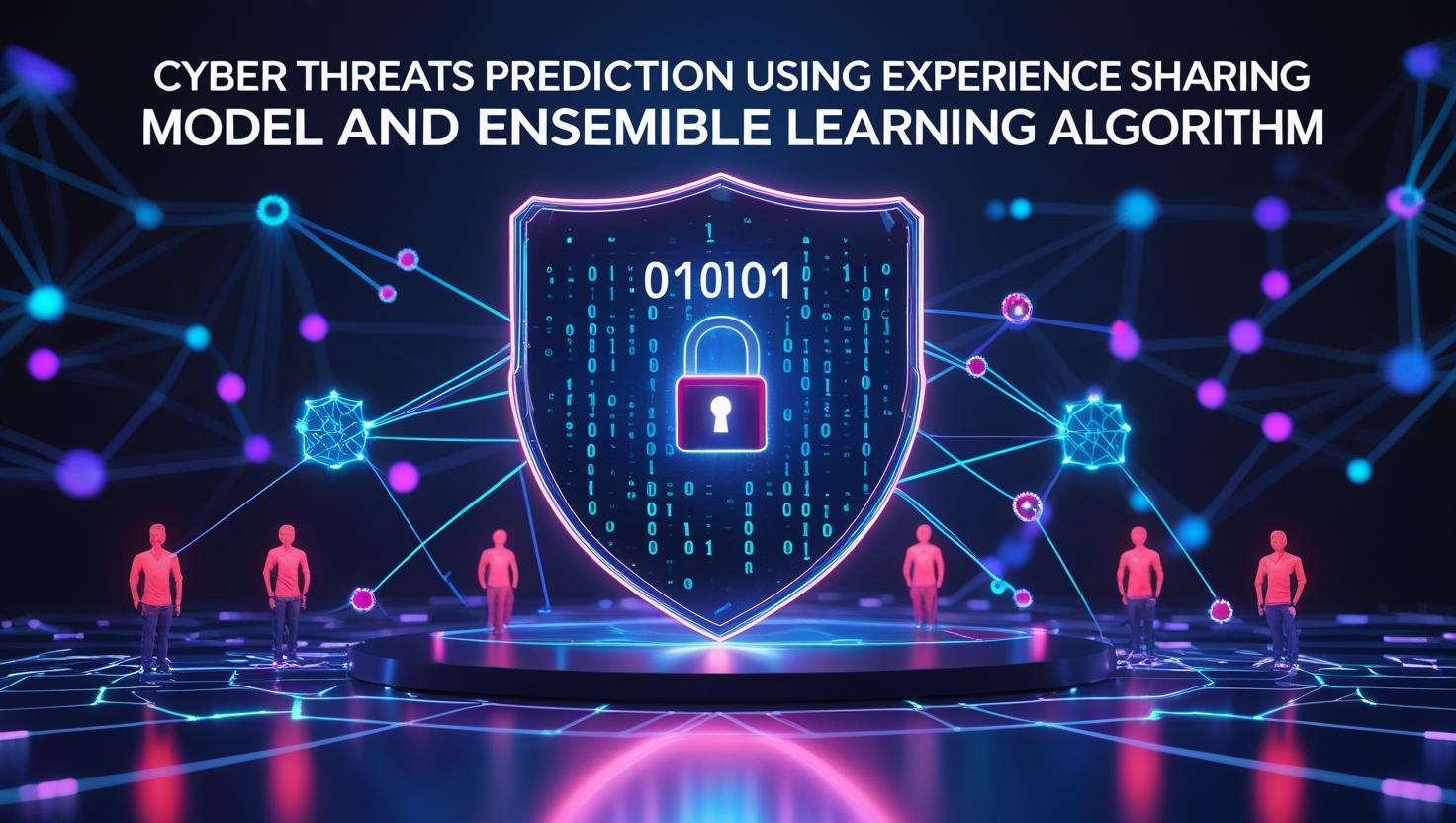
CYBER THREATS PREDICTON USING EXPERIENCE SHARING MODEL AND ENSEMBLE LEARNING ALGORITHM
Title
CYBER THREATS PREDICTON USING EXPERIENCE SHARING MODEL AND ENSEMBLE LEARNING ALGORITHM
Author
1. Abubakar Bello, Student, National Open University of Nigeria, Nigeria
Abstract
The increasing complexity of cyber
threats, particularly in critical industries such as oil and gas, necessitates
proactive predictive models for early detection and response. Traditional
frameworks such as the Common Vulnerability Scoring System (CVSS) are reactive,
often addressing vulnerabilities post-incident, thereby exposing organizations
to operational and financial risks. This study proposes a novel hybrid
framework combining an experience-sharing model with ensemble machine learning
algorithms, including bagging and boosting techniques. Using structured
datasets such as VERIS and CAPEC, machine learning classifiers—logistic
regression, k-Nearest Neighbors, and regression trees—were employed and
validated using k-fold cross-validation. The results revealed a 94% prediction
accuracy and a 0.96 AUC-ROC score with bagging ensembles, outperforming
conventional models by 12%. A case study focused on Nigeria’s oil and gas
infrastructure validated the model’s sector-specific applicability. This study
contributes to cybersecurity analytics by demonstrating (1) the efficacy of
ensemble learning, (2) a validated experience-sharing paradigm, and (3) the
development of dynamic cyber-risk metrics suited for modern threats. The
proposed framework offers cost-effective and scalable solutions for proactive
threat mitigation.
Keywords
Conclusion
This study demonstrates the applicability
of ensemble machine learning models for predicting cybersecurity threats, with
a focus on critical infrastructure such as the Nigerian oil and gas sector.
Using structured datasets and cross-validated ensemble models, the research
achieved high accuracy and reliability. Notably, Random Forest and Gradient
Boosting models performed best across key evaluation metrics.
Key contributions include the development
of a domain-specific cyber threat prediction model, integration of
experience-sharing frameworks, and validation of ensemble methods for
cyber-risk quantification. These outcomes are particularly relevant for sectors
requiring preemptive resource allocation and security incident mitigation.
Future research should explore deep
learning models, zero-day threat detection, and real-time deployment
integration with SIEM platforms. Localized datasets and cross-organizational
collaboration can further enhance the model's utility and adaptability.
Author Contrubution
A.B.: Conceptualization, Methodology (ensemble learning model), Writing – Original Draft. A.B.: Software (Python implementation), Data Curation (VERIS/CAPEC datasets), Formal Analysis. A.S.: Validation (k-fold cross-validation), Writing – Review & Editing. A.B.: Supervision, Project Administration
Funding
This research received no external funding
Conflict of Interest
The authors declare no conflict of interest
Data Sharing Statement
The datasets analyzed in this study—VERIS (Vocabulary for Event Recording and Incident Sharing) and CAPEC (Common Attack Pattern Enumeration and Classification)—are publicly available at their respective sources: VERIS Community Database and CAPEC MITRE Repository. The derived datasets and code used for ensemble learning analysis are available from the corresponding author upon reasonable request.
Software And Tools Use
This study was implemented using Python 3.8 with key libraries including Scikit-learn (v1.0) for ensemble learning algorithms (bagging/boosting), Pandas (v1.3) for data processing, and Matplotlib (v3.4) for visualization. The analysis was conducted in Jupyter Notebook and Google Colab environments. Anaconda (v2021.05) was used for package management
Acknowledgements
We thank the Petroleum Technology Development Fund (PTDF), Nigeria, for their institutional support. We also acknowledge the VERIS and CAPEC communities for providing open-access datasets critical to this research. Special gratitude to ACETEL at National Open University of Nigeria for their technical guidance and to the anonymous reviewers for their constructive feedback.
Corresponding Author
Abubakar Bello
National Open University of Nigeria, Student, Nigeria
Copyright
Copyright: ©2026 Corresponding Author. This is an open access article distributed under the terms of the Creative Commons Attribution License , which permits unrestricted use, distribution, and reproduction in any medium, provided the original author and source are credited.
Bello, Abubakar. “CYBER THREATS PREDICTON USING EXPERIENCE SHARING MODEL AND ENSEMBLE LEARNING ALGORITHM.” Scientific Research Journal of Science, Engineering and Technology, vol. 3, no. 1, 2025, pp. 17-22, https://isrdo.org/journal/SRJSET/currentissue/cyber-threats-predicton-using-experience-sharing-model-and-ensemble-learning-algorithm
Bello, A. (2025). CYBER THREATS PREDICTON USING EXPERIENCE SHARING MODEL AND ENSEMBLE LEARNING ALGORITHM. Scientific Research Journal of Science, Engineering and Technology, 3(1), 17-22. https://isrdo.org/journal/SRJSET/currentissue/cyber-threats-predicton-using-experience-sharing-model-and-ensemble-learning-algorithm
Bello Abubakar, CYBER THREATS PREDICTON USING EXPERIENCE SHARING MODEL AND ENSEMBLE LEARNING ALGORITHM, Scientific Research Journal of Science, Engineering and Technology 3, no. 1(2025): 17-22, https://isrdo.org/journal/SRJSET/currentissue/cyber-threats-predicton-using-experience-sharing-model-and-ensemble-learning-algorithm
1653
Total words842
Unique Words95
Sentence15.442105263158
Avg Sentence Length0.1832380952381
Subjectivity-0.013200501253133
PolarityText Statistics
Viewed / Downloads
Total article views: 66 (including HTML, PDF, and XML)| HTML | XML | Total | |
|---|---|---|---|
| 36 | 8 | 22 | 66 |
Viewed (geographical distribution)
Thereof 66 with geography defined and 0 with unknown origin.